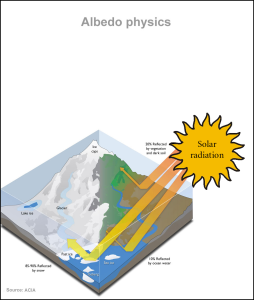Luisa Cristini, PhD, University of Hawaii at Manoa.
[Note from the editor: This is the fourth in a series of blog entries that will focus on introductory topics in climate dynamics and modeling, and will be a great insight into the current understanding of the science.]
Many characteristics of the climate are influenced by the land surface. For instance, big mountain chains are powerful barriers to the winds influencing climate on a continental scale. Mountains also have an important role at the hemispheric scale by affecting planetary waves and the global atmospheric circulation. The distance to the coast influences the temperature and aridity of a region. The ocean bathymetry affects the location of the strong boundary currents and the water exchanges between the different basins. The shape and even the existence of ice sheets are strongly influenced by the underlying bedrock.
In addition to the geometry, the type of vegetation present on land also has a critical influence on climate at all spatial and temporal scales. One of the most important roles of terrestrial vegetation is related to its albedo, i.e. the capacity of a surface to reflect solar radiation. The albedo is maximum over lighter surfaces and minimum over darker surfaces. Vegetation usually has a lower albedo than soil, in particular much smaller than that of deserts. Maximum albedo is observed at high latitudes because of the presence of snow and ice. At these latitudes, vegetation strongly modulates the influence of the snow. In the absence of vegetation, snow can cover the whole area, leading to highly reflective white areas with high albedo. If snow falls on a forest, relatively dark trunks, branches, and possibly needles or leaves will partially emerge from the snow, resulting in a much lower albedo than with a homogenous snow blanket.
The terrestrial biosphere also has an impact on the hydrological cycle. Water storage is greater in soil covered by vegetation than on bare land, where direct runoff often follows precipitation. Stored water can later be taken up by plant roots and transferred back to the atmosphere by evapotranspiration, i.e. the transfer of water from the land to the atmosphere as a sum of evaporation from soil, leaves, etc., and transpiration of plants. Vegetation cover also influences the stress at the atmosphere-land interface and the turbulent exchanges at the surface through a quantity called surface roughness. Finally, the terrestrial biosphere also has an important role in the presence of the global carbon cycle, as we will see later on.
Because of this climatic role of vegetation, scientists usually describe its general distribution in terms of “biomes”, which are regions with distinctive large-scale vegetation types. Natural biomes can be classified into five groups according to their typical percentage of grass and trees:

A qualitative chart of typical biome classification by average temperature and annual precipitation. Reproduced from Marietta College
(1) desert, characterized by a very small amount of vegetation;
(2) grassland, mainly covered by grass and lichens, which can be found at various latitudes and includes tundra, steppe, and savannah;
(3) shrubland, where low woody plants are present in addition to grass;
(4) woodland, where the fraction of trees is higher, but there are still significant areas covered by grass; and
(5) forest, densely covered by trees, as in tropical rainforest and boreal conifer forest, also called taiga.
Cropland and built-up areas can be added to take into account the role of land use associated with human activities.
As climate is influenced by vegetation, climate also influences vegetation, leading to powerful feedbacks. The dominant features of the climate are achieved through the distribution of incoming solar radiation, temperature and precipitation. If precipitation and/or temperature are too low, desert biomes dominate (as in the Sahara or Antarctica). At higher temperatures, forests can be maintained if a sufficient supply of water by rainfall is available. Between those two extremes, many different (and beautiful) combinations of grass and trees are found.
Reference
Goosse H., P.Y. Barriat, W. Lefebvre, M.F. Loutre and V. Zunz, (2012). Introduction to climate dynamics and climate modeling. Online textbook available at http://www.climate.be/textbook.


Comments are closed.